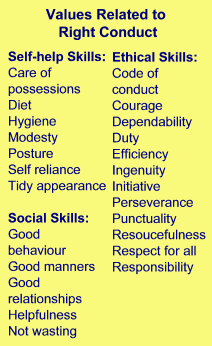Values & Methodology
Fundamental Values
Values & Methodology
Fundamental Values
|
|
The Sathya Sai EHV Programme is based on the five core human values:
The Programme's logo is the tree of life bearing five fruits, each used to represent a value. These symbols are particularly effective when used with young children who find them easy to remember:
The
values are specific because they are in line with a human being’s make
up. They are also heavily interrelated (e.g. right conduct is action with
love, and according to conscience) and give rise to many related values
under each main heading.
The
Values are taught through five teaching components:
Before explaining these teaching components, each value is explained briefly below:
Right
Conduct
Right conduct is also concerned with how we look after and use our bodies. The body needs to careful maintenance to be strong, healthy and well co-ordinated to serve us in performing the tasks of life. Students need to understand the importance of exercise, such as gymnastics,yoga and sports combined with good rest. Good thoughts and good company (which includes everything imbibed by the five senses) are essential for healthy and well balanced development. Right conduct is taught through:Silent Sitting, Story telling and Group Activities.
Peace
Inner agitation stops and we are left feeling peaceful. When there is peace in the individual, there will be peace in the family. When there is peace in the family, there will be peace in the community. In order to learn, self-esteem, calmness and freedom from anxiety are necessary. These qualities are fostered by two of the Programme's components, namely silent sitting and the self-reflective exercises in some of the group activity sessions.
Truth
One great distinction between humankind and the rest of the animal kingdom is the ability to choose how to behave, rather than just to follow the lower instincts (the law of the jungle). A human being is also able to recognise past, present and future and to take note of changes occurring over time. A quotation used in the lesson to stimulate thought and questions, may later come to mind to provide guidance and choice in a life situation. Short Term Pain for Long Term Gain: Choosing to refer to this higher level of awareness and to consciously exercise moderation in our behaviour leads to better health and greater contentment. The value of truth can also be taught through story telling which promotes curiosity, optimism, fairness to all and noble ideals. It also aids the understanding of the value of honest speech and self-analysis.
Love
It
is the power of love which causes one person to wish happiness for another
and take pleasure in their well-being. A beneficial energy (love) is directed
towards the other person. As this energy flows through our own body first,
it also enhances our own health. Love is unconditional, positive regard
for the good of another. It is giving and unselfish. Love is essential
if children are to grow up healthy in mind and body. Love is the unseen
undercurrent binding all the four values.
When the mind is turned away from selfishness, the 'heart' opens, and love flows. Love is an energy, not an emotion, and is inherent in every breath. It is the motive force of the physical body and is enhanced through breathing exercises. The component of group singing in the Programme promotes harmony, co-operation and joyfulness. In singing a child may experience the sweetness of love. Love may also be fostered through story telling and activities which provide young people with the opportunity to care for other people, animals, plants and objects.
Non-Violence
Non-violence can be described as universal love. When truth is glimpsed through intuition, love is activated. Love is giving, rather than grasping and in allowing our stream of desires to subside, inner peace develops and right conduct is practised. This results in nonviolence i.e. the non-violation of the natural laws which create harmony with the environment. Living in a way which causes as little harm as possible to oneself, other people, animals, plants and the planet, is a sign of a well-integrated, well-balanced personality. Such a person is well tuned to the spiritual aspect of humanity and is in touch with an inner happiness which is permanent and part of one's real nature. It is through our universal or spiritual aspect that we may experience:
Non-violence is taught through quotations, story telling and group activities. True knowledge is that which establishes harmony and synthesis between science on the one hand and spirituality and ethics on the other. Continue to: The Teaching Components
|
||||||||||||||||||||
|
|
|||||||||||||||||||||
 |
|||||||||||||||||||||
|
|
|||||||||||||||||||||
|
|
|||||||||||||||||||||
|
|
|||||||||||||||||||||
|
|
|||||||||||||||||||||